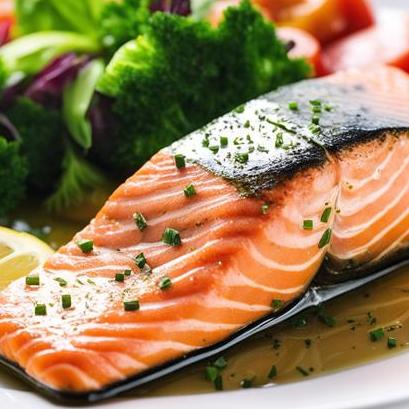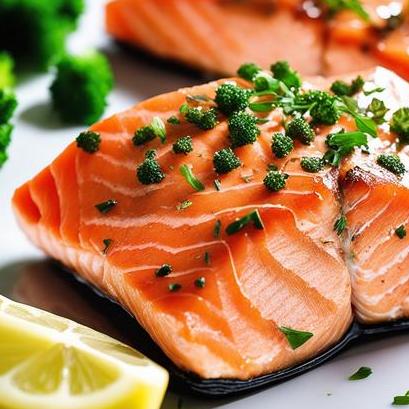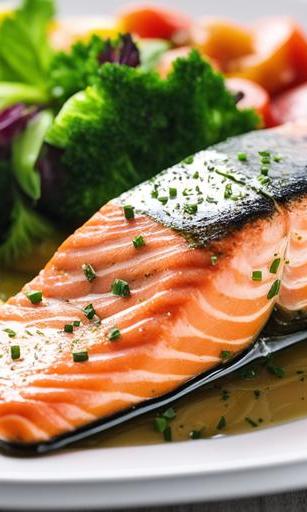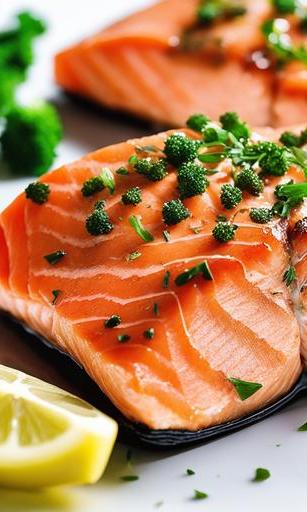[GUIDE] How Long To Cook Fresh Salmon In Oven

Cooking fresh salmon in the oven is a popular and delicious way to prepare this healthy and flavorful fish. However, many people may wonder about the exact cooking time needed to achieve the perfect results. In this article, we will delve into the science of cooking fresh salmon and provide detailed instructions and tips on how to cook it to perfection in the oven.
Quick Answer: How Long To Cook Fresh Salmon In Oven
The cooking time for fresh salmon in the oven depends on several factors, including the thickness of the fillet, the desired level of doneness, and the oven temperature. As a general rule, you can cook fresh salmon in the oven at 375°F (190°C) for approximately 12-15 minutes per inch (2.5 cm) of thickness.
However, it’s important to monitor the cooking process closely, as overcooking can result in dry and tough salmon. To determine if the salmon is properly cooked, use a thermometer to ensure the internal temperature reaches 145°F (63°C) at its thickest part.
Key Takeaways
- The cooking time for fresh salmon in the oven depends on the thickness of the fillet and the desired level of doneness.
- As a general rule, cook fresh salmon at 375°F (190°C) for 12-15 minutes per inch (2.5 cm) of thickness.
- Use a thermometer to check the internal temperature of the salmon, which should reach 145°F (63°C).
The Science Of Cooking Fresh Salmon

To understand how to cook fresh salmon to perfection, it’s helpful to take a closer look at the science behind the cooking process. When salmon is cooked, its muscle fibers contract, and its proteins denature, resulting in a firmer texture and opaque appearance. The speed at which these changes occur depends on factors such as the cooking temperature and the thickness of the fillet.
Choosing Fresh Salmon
Before cooking fresh salmon, it’s important to choose high-quality fillets. Here are some tips for selecting the best fresh salmon:
- Look for wild-caught salmon that is sustainably sourced.
- Choose fillets that have a vibrant, firm texture and a mild, fresh scent.
- Avoid fillets with slimy or discolored areas.
Freshness is key when it comes to achieving the best flavor and texture in your cooked salmon.
Preparing Fresh Salmon

Before cooking fresh salmon, there are a few crucial steps to follow for optimal results:
- Rinse the salmon under cold water and pat it dry with paper towels.
- Remove any remaining scales, pin bones, or visible blood vessels using tweezers or fish pliers.
- Season the salmon with salt, pepper, and any desired herbs or spices.
Taking the time to properly prepare the salmon ensures even cooking and enhances the overall taste.
Ideal Cooking Temperature For Fresh Salmon
The ideal cooking temperature for fresh salmon in the oven is 375°F (190°C). This temperature allows the fish to cook evenly without drying out. Higher temperatures can result in overcooked salmon, while lower temperatures may not fully cook the fish.
Fresh Salmon Cooking Time

The cooking time for fresh salmon in the oven depends primarily on the thickness of the fillet. As a general guideline, aim for approximately 12-15 minutes of cooking time per inch (2.5 cm) of thickness. However, it’s essential to adjust the cooking time based on the specific thickness of your salmon fillet.
Refer to the table below for a more precise estimate of the cooking time based on fillet thickness:
| Fillet Thickness | Cooking Time |
|---|---|
| 1/2 inch (1.27 cm) | 6-8 minutes |
| 1 inch (2.5 cm) | 12-15 minutes |
| 1 1/2 inches (3.8 cm) | 18-22 minutes |
| 2 inches (5 cm) | 24-30 minutes |
It’s important to note that these times are approximate and may vary depending on factors such as the oven’s efficiency and the desired level of doneness.
Cooking Techniques
When cooking fresh salmon in the oven, there are a few techniques you can employ to enhance the flavors and achieve the desired texture:
-
Baking: Place the seasoned salmon fillets on a baking sheet lined with parchment paper or aluminum foil. This technique provides a gentle and even heat distribution, resulting in a moist and tender final product.
-
Broiling: By placing the salmon on a broiler pan or a baking sheet set close to the broil element, you can quickly sear and brown the top of the salmon fillet. This technique is excellent for adding a flavorful crust to the fish.
-
En Papillote: This French cooking method involves wrapping the seasoned salmon in parchment paper or aluminum foil before baking. The steam created inside the package helps to keep the fish moist and intensifies the flavors.
-
Roasting: By cooking the salmon in a preheated oven at a higher temperature (around 425°F/220°C), you can achieve a slightly crisp exterior while maintaining a moist and flaky interior.
Experimenting with different cooking techniques can add variety and excitement to your fresh salmon dishes.
Monitoring And Troubleshooting

To ensure perfectly cooked fresh salmon, it’s essential to monitor the cooking process closely and address any potential issues that may arise. Here are some tips for troubleshooting common problems:
-
Dry Salmon: Overcooking can result in dry and tough salmon. To prevent this, you can reduce the cooking time slightly or lower the oven temperature. Aim for an internal temperature of 145°F (63°C) at the thickest part of the salmon.
-
Undercooked Salmon: If you find that your salmon is undercooked, return it to the oven for a few more minutes or boost the oven temperature slightly. Remember to keep a close eye on the fish to prevent overcooking.
-
Uneven Cooking: If your salmon is thicker in some areas than others, it may cook unevenly. To resolve this issue, you can cut the thicker parts into smaller pieces or use a fillet that is of more consistent thickness.
By being vigilant during the cooking process and making adjustments as needed, you can overcome any potential challenges and achieve fantastic results.
[quote] Pro Tip: To prevent the salmon from sticking to the baking sheet, you can brush the sheet with a little olive oil or use parchment paper.[/quote]
Fresh Salmon Cooking Instructions
Now that we have covered the key principles and techniques, let’s explore the step-by-step instructions for cooking fresh salmon in the oven:
-
Preheat the oven to 375°F (190°C).
-
Rinse the fresh salmon fillets under cold water and pat them dry with paper towels.
-
If needed, remove any scales, pin bones, or visible blood vessels using tweezers or fish pliers.
-
Season the salmon with salt, pepper, and any desired herbs or spices.
-
Place the seasoned salmon fillets on a baking sheet lined with parchment paper or aluminum foil.
-
Bake the salmon in the preheated oven for approximately 12-15 minutes per inch (2.5 cm) of thickness.
- Remember to adjust the cooking time based on the specific thickness of your salmon, referring to the table provided earlier in the article.
-
To ensure the salmon is fully cooked, use a thermometer to check the internal temperature. The salmon should reach 145°F (63°C) at the thickest part.
-
Once the salmon reaches the desired temperature, remove it from the oven and let it rest for a few minutes before serving.
Variations

Cooking fresh salmon in the oven allows for various flavors and ingredient combinations. Here are a few variations to consider:
-
Citrus Glazed Salmon: Create a glaze using a combination of fresh citrus juice, honey, soy sauce, and minced garlic. Brush the glaze onto the salmon fillets before baking for a tangy and sweet flavor.
-
Herb-Crusted Salmon: Mix together finely chopped herbs such as parsley, dill, and thyme with breadcrumbs and olive oil. Pat the mixture onto the salmon fillets before baking for a crispy and fragrant crust.
-
Asian-inspired Salmon: Marinate the salmon in a mixture of soy sauce, sesame oil, ginger, and garlic. Bake the fillets with a drizzle of honey for a delicious umami flavor.
Feel free to get creative and adapt these variations based on your personal preferences and taste.
When Things Go Wrong
Even with careful monitoring, occasionally things may go wrong during the cooking process. Here is how to address common issues:
-
Overcooked Salmon: If the salmon is dry and overcooked, try to salvage it by adding a flavorful sauce or dressing before serving. This can help improve the overall taste and texture of the dish.
-
Undercooked Salmon: In the case of undercooked salmon, return it to the oven for a few more minutes or finish cooking it in a skillet on the stovetop.
-
Sticking to the Baking Sheet: If the salmon sticks to the baking sheet, carefully loosen it with a spatula or use a metal fish spatula, which is designed to prevent sticking.
Remember, even if things don’t go as planned, it’s an opportunity to learn and improve for your next cooking adventure.
Serving Fresh Salmon

When serving fresh salmon, there are numerous accompaniments and side dishes that complement its flavors. Here are a few ideas:
-
Roasted Vegetables: Serve the salmon alongside a medley of roasted vegetables such as asparagus, carrots, and zucchini.
-
Herbed Rice or Quinoa: Pair the salmon with a fluffy and aromatic herbed rice or quinoa for a complete and satisfying meal.
-
Fresh Salad: Serve the salmon on a bed of crisp greens, along with cherry tomatoes, cucumbers, and a tangy vinaigrette for a light and refreshing option.
-
Creamy Dill Sauce: Prepare a creamy dill sauce to drizzle over the cooked salmon, adding a delightful tang and freshness.
The choice of accompaniments is subjective, so feel free to experiment and find your favorite combinations.
Best Practices For Fresh Salmon Cooking
To ensure the best possible outcome when cooking fresh salmon in the oven, keep the following tips in mind:
-
Invest in a good thermometer: A thermometer is an essential tool for cooking salmon to the perfect temperature. It ensures food safety and avoids overcooking.
-
Allow the salmon to rest: After removing the salmon from the oven, let it rest for a few minutes before serving. This allows the juices to redistribute, resulting in a more flavorful and tender fish.
-
Experiment with flavors: Fresh salmon is versatile and pairs well with a wide range of herbs, spices, and marinades. Don’t be afraid to experiment with different flavor combinations to discover your favorite.
-
Tailor the cooking time: Adjust the cooking time based on the thickness of the salmon to achieve the desired level of doneness. Use the suggested times as a guideline but rely on a thermometer for accurate results.
Conclusion
Cooking fresh salmon in the oven is a foolproof way to enjoy this nutritious and delicious fish. By following the recommended cooking temperature, monitoring the cooking time, and making any necessary adjustments, you can achieve perfectly cooked salmon with a moist and flaky texture. Remember to experiment with different cooking techniques and flavor combinations to create your own signature salmon dishes. Whether you’re a seafood lover or a novice cook, oven-baked fresh salmon is a versatile and delightful meal option.
FAQS
What Is The Ideal Temperature For Cooking Fresh Salmon In The Oven?
The ideal temperature for cooking fresh salmon in the oven is 400°F. This ensures that the fish is cooked through, but does not dry out or become overcooked.
How Long Should I Cook Fresh Salmon In The Oven If It Is A Large Piece?
If you have a large piece of fresh salmon, you should plan to cook it for approximately 15-20 minutes in the oven. Be sure to check it periodically to ensure that it is cooking evenly and not overcooking.
Can I Cook Fresh Salmon In The Oven Without Seasoning It?
While you certainly can cook fresh salmon in the oven without seasoning it, the fish will likely benefit from at least a little bit of seasoning. A sprinkle of salt and pepper, some garlic powder, or a squeeze of lemon juice can all enhance the natural flavor of the salmon.
How Do I Know When Fresh Salmon Is Fully Cooked In The Oven?
To determine whether fresh salmon is fully cooked in the oven, use a meat thermometer to check that the internal temperature has reached 145°F at its thickest point. Alternatively, check the fish for flakiness and opacity, as fully cooked salmon will be opaque and easily flake apart with a fork.
Is It Okay To Cook Fresh Salmon In The Oven With The Skin On?
Yes, it is absolutely fine to cook fresh salmon in the oven with the skin still on. In fact, leaving the skin intact can help to keep the fish moist and prevent it from sticking to the baking dish. Plus, it is easy to remove the skin after the salmon has finished cooking.
Sources
About the Author Jenny
I'm Jenny, a housewife with an unwavering passion for food. My culinary journey began with my grandmother's kitchen, and it's now a full-fledged food blog. I've turned my love for cooking into a creative outlet, sharing recipes and stories with a global community of fellow food enthusiasts. It's proof that being a housewife can also mean pursuing your passions and savoring life's delectable moments.
